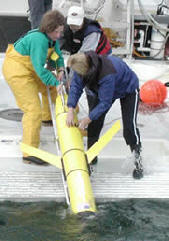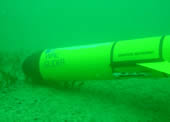|
Robot gliders to watch red tides
Winged underwater vehicles could forecast toxic blooms of plankton.
23rd January 2003
TOM CLARKE
Courtesy Nature News Service
Gliders will record temperature, salt and plankton levels.
Photo:Rutgers University
Winged robots were released into the Gulf of Mexico last week to help forecast and study red tides - the mysterious blooms of toxic plankton that kill fish, poison food and choke swimmers.
This is the test phase of a year-long project to follow red tides using autonomous underwater vehicles, or AUVs - a first for ocean scientists. "We're definitely breaking some new ground," says marine ecologist Gary Kirkpatrick of the Mote Marine Laboratory in Sarasota, Florida.
Equipped with miniature sensors of a type normally dipped over the sides of research ships, the AUVs will survey huge areas of ocean, supervised from the comfort of shore. Hopefully they will maintain a year-round watch on red tides, says Kirkpatrick.
The reddish plankton Karenia brevis grows throughout the Gulf of Mexico. Occasionally, in autumn, it forms dense blooms that contain a nerve toxin. The toxin renders shellfish inedible and makes sea spray irritant to the eyes and lungs.
The glider team hopes that their data, combined with satellite images, will alert coastal communities of an approaching tide. "Two days' warning could really help the clam-farming industry," says Kirkpatrick. Farmers could harvest clams early or move them to avoid losses.
The 2-metre gliders carry sensors to detect Karenia brevis cells, as well as recording the temperature and salinity of water. These could also give researchers crucial information about how and why red tides form.
"They have incredible potential," says red tide expert Gabriel Vargo at the University of South Florida in St Petersburg. The causes of some red tides in other oceans have been deciphered, but Florida's remain a mystery. Sampling continuously, the gliders should be able to watch a tide forming and relate that to the physical and chemical characteristics of the ocean at the time.
Rise and fall
Like aerial gliders, the AUVs' wings generate lift
as they sink through the water - they glide around
20 metres for every 10 that they sink. When they
hit the bottom, or at a pre-determined depth, a tiny
electrical motor pumps oil into external tubes,
causing the robot to float to the surface.
|

